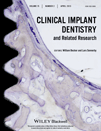Localized Management of Sinus Floor Technique for Implant Placement in Fresh Molar Sockets
ABSTRACT
Background: The use of osteotome for vertical bone augmentation and localized sinus elevation with minimal surgical trauma represents a suitable procedure to increase the vertical dimension of available bone for implant placement.
Purpose: The aim of this study was to report clinical and radiographic results of localized management of sinus floor (LMSF) in fresh molar sockets at 13-year follow-up.
Materials and Methods: Fifty-three patients, needing one or two maxillary molar extraction, were enrolled in this study. LMFS procedure was performed and 68 implants were positioned. A presurgical distance from the alveolar crest to the floor of the maxillary sinus and the amount of new radiopacity between the sinus floor and alveolar crest were measured from the mesial and distal surfaces of each dental implant surface.
Results: After a mean follow-up period of 9.76 ± 5.27 years (ranged from 4 to 17 years) a survival rate of 100% was reported. Mean bone height at temporary prosthesis placement was 7.99 ± 1.16 mm. They were stable over time, reporting a mean value of 8.01 ± 1.46 mm at 13-year follow-up.
Conclusions: The results of this study demonstrated that LMSF procedure in fresh molar sockets allowed to expand the dimensions of resorbed posterior maxillary alveolar bone both vertically and horizontally with a success rate of 100% of implant osseointegration over time.




